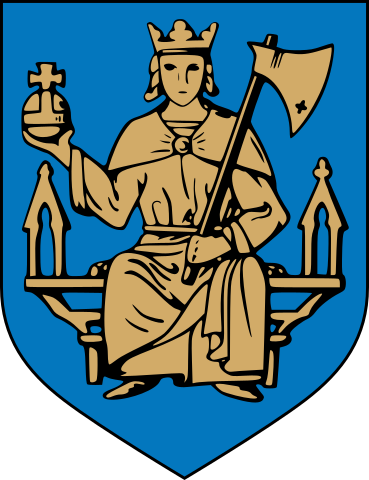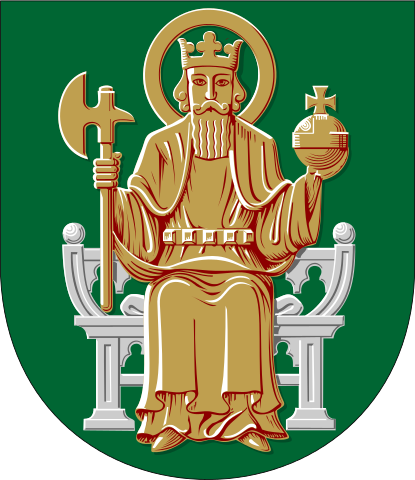St. Olaf as a Symbol in Finland
2021-06-23

How St. Olaf
- came to Finland (twice)
- influenced Finnish Christianity
- is still visible in Finnish municipal heraldry
This summer I will be focusing much of my writing and research on Olaf II Haraldsson, also known as St. Olaf. Olaf, viking raider and king of Norway from 1015 to 1028, is the patron saint of Norway. His saint’s cult became a core element of the conversion and Christian institutions of Norway, and over time spread to other parts of the world as well. These days one of the most widely recognized places bearing St. Olaf’s name is St. Olaf’s College in Northfield, Minnesota, founded by Norwegian-American immigrants to the USA. In this blog post I will be focusing on the presence of St. Olaf and his symbols in Finnish municipal heraldry.
Widespread awareness of St. Olaf came to Finland with the Northern Crusades in the twelfth century, as Swedish crusaders brought Christianity with them. However, according to Snorri Sturluson’s Heimskringla Olaf raided Finland during his youth as a viking raider, retreating from a losing battle at Herdaler – a place probably located in Uusimaa-province, but which has not been convincingly identified. Though more recently churches built in the region have been dedicated to St. Olaf, most of the medieval sites dedicated to Olaf are situated in Western and Central Finland. Among medieval Finnish stone churches with known patron saints, St. Olaf is one of the most popular patrons alongside the Virgin Mary and the Holy Cross. St. Olaf is not just treated as the patron saint of Norway, but alternately as the patron saint of seafarers, knights and soldiers, and Åland. Interestingly, St. Erik, the patron saint of Sweden, is far less popular than Olaf in the dedications of medieval stone churches in Finland – puzzling, given that following the Northern Crusades Finland was firmly part of the Kingdom of Sweden, and it would have been in the interest of the kingdom to promote its own patron saint in its Eastern provinces. For reasons which I will explore later in the summer, this didn’t happen.
Let’s correct our course and get back to municipal heraldry. Municipal heraldry are coats of arms used as symbols by municipalities. Finland’s culture of municipal heraldry can be traced back to the medieval period, but the current designs in most of Finland date to the 1950’s – 1960’s. Out of the current and former municipal coats of arms of Finland, five feature St. Olaf or his characteristic axe-symbol. The reason for all these municipalities featuring St. Olaf in their heraldry is that all of them are home to a medieval Finnish church dedicated to St. Olaf.
The saint himself is depicted on the arms of Jomala in Åland and Ulvila in Satakunta.

The municipal heraldry of Jomala, Åland, depicting St. Olaf, designed by Matts Dreijer.

The municipal heraldry of Ulvila, Finland, also depicting St. Olaf, designed by Ahti Hammar.
Of these two I personally prefer Ulvila to Jomala 6-0; the green-and-gold color scheme stands out from the majority of Finnish municipal heraldry, and stylistically Ahti Hammar’s depiction of St. Olaf with full beard and halo is more striking than Matts Dreijer’s beardless, haloless design. As a side-note, Matts Dreijer, who designed most of the municipal heraldry for the municipalities of Åland, while crafting an internally consistent group of solid designs was not a very talented artist, as you can see from his original drawing for the Jomala coat of arms below.

The original municipal heraldry of Jomala, Åland, designed by Matts Dreijer.
Terrifying, right?
The other Finnish municipal coats of arms paying homage to St. Olaf do so indirectly, using St. Olaf’s iconic axe, a symbol associated with the saint since the Middle Ages. These are the coats of arms of the former municipalities of Kalvola and Tyrvää, as well as the still extant municipality of Sysmä.

The municipal heraldries of Kalvola (designed by Olof Eriksson), Tyrvää (designed by Gustaf von Numers), and Sysmä (designed by Ahti Hammar).
The axe is a useful symbol in that it can also be used to represent the significance of forestry to the municipal economy and lifestyle, whilst the style of axe used in these coats of arms creates a direct tie to the medieval history of religion in the area. It’s also interesting to consider the varying degrees of prominence given to St. Olaf’s symbol. Where Sysmä and Kalvola display the axe very prominently, Tyrvää attached it to the goat rampant, making it stand out less. Out of these three I prefer Sysmä’s heraldry, mainly because of the terrific black-silver-red coloration and the thematic unity of including objects which serve both as tools as well as weapons.
The choice to commemorate a patron saint in Finnish municipal heraldry is not all that frequent. While Finland is still a majority Christian country, thanks to the Reformation saints do not play a significant role in the religious practices or doctrine of most Finns. In this light, I understand the choice of the heraldists in incorporating the municipalities’ ties to St. Olaf in a minor, symbolical element rather than depicting St. Olaf in all his glory, however visually the coats of arms of Jomala and Ulvila appeal to me more than these latter three, which seem somewhat cluttered. While the cult of St. Olaf may be long gone from Finland, his figure lives on, proudly displayed as a symbol of local heritage.